This is one of the more popular posts at New Savanna, and it's about one of my favorite anime series. Enjoy.I want to describe what happens in a brief scene (less than two minutes) in a popular anime series Azumanga Daioh, which is based on a manga series of the same name. It presents vignettes in the lives of a group of Japanese school girls during their three years together in high school. It has no overall plot.
This scene centers on two of the girls, Sakaki and Osaka (her nickname). I’m particularly interested in a 10-15 second segment near the end of the scene. This segment focuses on Sakaki.
While there is no overt sexuality in this scene, no sexual action, no talk of sex, this particular 10 second segment – in which Sakaki daydreams of riding a dolphin – is dripping with sexual overtones in the way the dream is cut into the scene. In one mode of analysis one might say that the dolphin ride is the overt content which hides (desire for) sex as its hidden content. I want to think about this segment in a different way. I don’t want so much to deny the hidden-content mode of analysis as I want to side-step it.
I’m interested in how the film works as film, how it works as something on which the mind can exercise its capacities. What happens is that this daydreamed dolphin ride cuts into a discussion of how certain sets of Japanese characters mean certain things. The discussion is thus rather cerebral while the (imagined) dolphin ride is deeply visceral. That dolphin ride, however, is as fully realized on the screen as the discussion is. In fact, it is more real to the viewer’s visual, somesthetic, and kinesthetic senses than the meanings of those characters.
That is what interests me.
On the Beach
This particular scene happens after the girls have been on the beech for awhile. At some point there’s a shot where we see Sakaki (to the left) and Chiyo (to the right). The camera is looking down from above. Chiyo is looking up at Sakaki and asks: “How did you get so big?” Sakaki covers her breasts with her arms. Sakaki is the tallest and most athletic of the girls. Chiyo is the smallest, because she’s also the youngest. She’s eleven, but was jumped into high school because she’s “a prodigy.”Then we have some other beach scenes and then there's a scene where Osaka and Sakaki are talking at the beach.
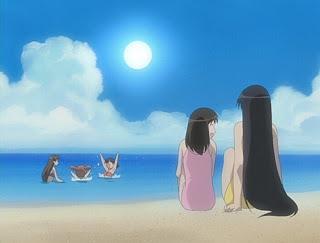 Just Talking
Just TalkingInitially we’re behind them looking out at sea, where we see three girls (Tomo, Yomi, and Chiyo) on the left, playing in the ocean, and, on the right, Osaka and Sakaki sitting on the beach. Chiyo is one of the girls in the ocean, with her back to us (we can see her pig tails waving as she jumps up and down). The sun is in the sky, above and to the left of center. Sakaki and Osaka are to the right of the picture, and both have their legs drawn up in front of them. Sakaki is leaning back with her hands behind her for support; her hair hangs down to the sand. Osaka is to her left, with her arms clasped under her knees. Let’s call this the sea shot.
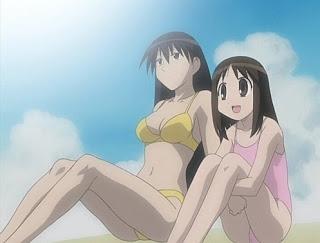 Sakaki and Osaka
Sakaki and OsakaThe camera then shifts to a point-of-view (POV) in front of Sakaki and Osaka, so that Sakaki is to the left and Osaka to the right. The camera is roughly at the level of Sakaki’s breasts, which are in the center of the shot. Note that, in contrast to Sakaki, Osaka is flat-chested. The girls are facing leftward, their backs to the right their feet to the left. Sakaki is wearing a orange-yellow bikini while Osaka is to the wearing a pink one-piece. Since their legs are drawn up you can just see a triangle of cloth covering their respective crotches. It’s a small detail, but in the overall ecology of anime, it’s important.
This shot is important because it is the basic shot throughout the sequence that interests me. As Osaka and Sakaki converse this shot is interrupted with other shots, but the “camera” always comes back to this shot. Let’s call this the base shot.
The sequence we’re examining begins when Osaka starts talking with Sakaki. This lists the shots, in order:
Base shot: talk about Japanese characters for hemorrhoidsThe base shot is set in ordinary type while the dolphin sequence is set in bold. Other shots are indicated in italics. The indentation gives my sense of the scene’s structure. The whole sequence lasts about 100 seconds while the dolphin sequence is roughly a tenth of that.
Base shot: talk about characters for seal
Base shot: Osaka: “I’d really like to ride a dolphin”Head shot of Sakaki: “That’d be nice.”Base shot: Yomi, “What are you two up to?”
Sea shot
Base shot: talk about characters for dolphin
Base shot: talk about characters for puffer-fish
Sea shotSakaki alone, at night, looking out to seaHead shot of Sakaki
Sakaki rides the dolphin
Cross dissolve
Hemorrhoids
Osaka brings up a peculiarity of the characters used for "hemorrhoids" (I assume some joke or pun in the Japanese but nothing comes though in the English).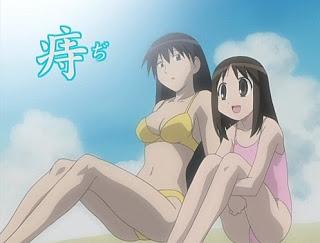 Hemorrhoids
HemorrhoidsThe Japanese characters are displayed on screen at the upper left of the base shot. Sakaki is a bit taken aback by this remark. This, presumably is not standard beach conversation, neither hemorrhoids nor the Japanese writing system. But Osaka is a space cadet, so this sort of remark is standard fare from her.
What interests me about this particular remark is the attention it calls to . . . well, it’s not just the buttocks and anus, but the interior. Hemorrhoids are inside the body or at the border between the inside and the outside. In any case, it’s an area that is normally concealed. And so it is with Sakaki and Osaka, but they are sitting just so that area of their bodies is at the edge of visibility but, by virtue of Osaka’s remark and Sakaki’s reply, at the center of the viewer’s attention.
But only for a moment. Osaka then makes a remark about the kanji for seal (literally, sea leopard--"looks cute, but must be really ferocious"). Osaka is looking steadily out toward the sea while Sakaki’s gaze moves around, from looking ahead, looking aside, looking at Osaka, etc. She remarks that Osaka’s pretty knowledgeable. “You think so?” Osaka replies.
Dolphin Thoughts
Then Osaka remarks, “thinking of the ocean, I’d really like to ride a dolphin.” Now the camera zooms in on Sakaki as she looks down and sighs; we’ve left the base shot. As Sakaki remarks “that’d be nice” the POV cuts behind the girls and, once again, we’re looking out at the sea; we’ve got the sea shot.The camera then switches back to the base shot and Osaka resumes her commentary on language, remarking on the kanji for dolphin ("sea pig" and puffer-fish (“river pig”). How come, she wonders, that this "river pig" lives in the sea?
The camera shifts again to the sea shot. We are behind Osaka and Sakaki, in effect, following their gaze as they watch their friends playing in the surf.
Very quickly, with no explanation, the scene darkens and all people disappear except Sakaki. The sun in the daytime sky becomes the moon in the nighttime sky and the clouds are different. Then, out at sea, a dolphin appears, and someone is riding it as Sakaki watches.
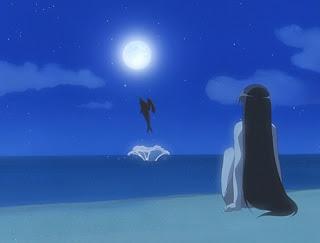
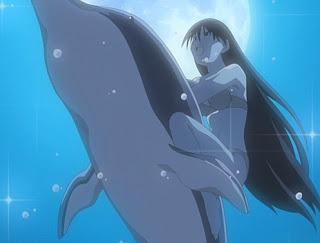 Ride the dolphin
Ride the dolphinWe zoom in and see that it's Sakaki riding the dolphin, silhouetted against the moon (which appears to be, say, 2/5 the diameter of the screen width).
Return
The “return” is accomplished through a cross-dissolve, the first one in this scene. The image of Sakaki riding the dolphin is dissolved with a the close-up.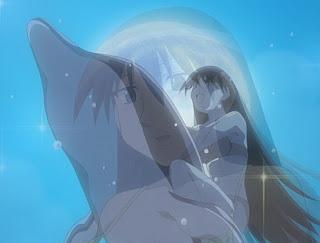 Cross dissolve
Cross dissolveThe dolphin ride dissolves out and we focus on Sakaki’s head, shoulders, and breasts. The camera continues moving back and Osaka comes into view on the right. Once again we’re in front of the girls, the base shot, looking at them as they sit on the beach discussing words, characters, and meanings. One of their friends, Yomi, enters from the left. “What are you two up to?” she asks. “Oh, thinking about hemorrhoids,” replies Osaka, which Sakaki denies. That’s the end of the sequence.
Some Comments
The first thing to note is that the majority of the time in this scene, which is about 100+ seconds long, we see Sakaki and Osaka side-by-side in the base shot. This is punctuated by other shots. That is, most of the time we see and hear just the two of them talking, but there are moments where we see the two in relation to the rest of their group and moments where Sakaki alone is in focus.Second, notice that the entire scene is framed by reference to hemorrhoids. Unless in a clinical setting this is, at best, an embarrassing subject for conversation. Except that, in the beginning, Osaka isn’t talking about hemorrhoids at all, she’s talking about how the word is written. But, judging by her reaction, Sakaki can’t help but thinking about hemorrhoids and I rather doubt that anyone in the audience can avoid thinking about hemorrhoids either. Thus our attention is momentarily focused on one of the taboo areas of the body.
Osaka’s final remark is simply about hemorrhoids, not the word, and comes just after Sakaki, presumably, has been day-dreaming about riding a dolphin in the moonlight – a sexual-romantic image. Along with having Sakaki’s breasts in the center of the scene and seeing those bits of cloth covering the girls crotches this whole scene is intimately involved with their bodies, even as Osaka talks about the “body” of language, its physical representation in written characters.
The most interesting segment, however, is that where Sakaki day-dreams about riding a dolphin. When I say “day dream” I am interpreting what is displayed in the film. The film itself does not explicitly put that interpretation before us. All of a sudden the sky gets darker and we see Sakaki and only Sakaki sitting on the beach. This transition is not signaled in any way, nor is it labeled. It just happens. It is up to the viewer to impose some interpretation on this, or not. Whatever the viewer may do, there is a clear discontinuity in the events on the screen, one for which there is no obvious naturalistic account.
Second, when the (virtual) camera zooms in on the dolphin, we see that it is Sakaki herself on its back. How is it possible for Sakaki to be in two places at once? Or is the figure on the beach someone else? But why would we think that? Given that the whole dolphin ride takes about 10 seconds, how much time does the viewer have to THINK about anything? Finally, we have the return, where we see dolphin-riding Sakaki superimposed on beach-sitting Sakaki. The two are undoubtedly there, in plain sight.
As I indicated up front, what interests me is what the film does, how it acts, in this scene. However the viewer chooses to interpret the break in ontological continuity, if you will, that break is irreducibly there. It is “beneath” and “prior to” conceptualization. At the same time, without the continuity demanded by conceptualization, there could be no perception of broken ontological continuity.
* * * * *
Question (20 Sept 2011): Would you like to see more posts about Azumanga Daioh?

